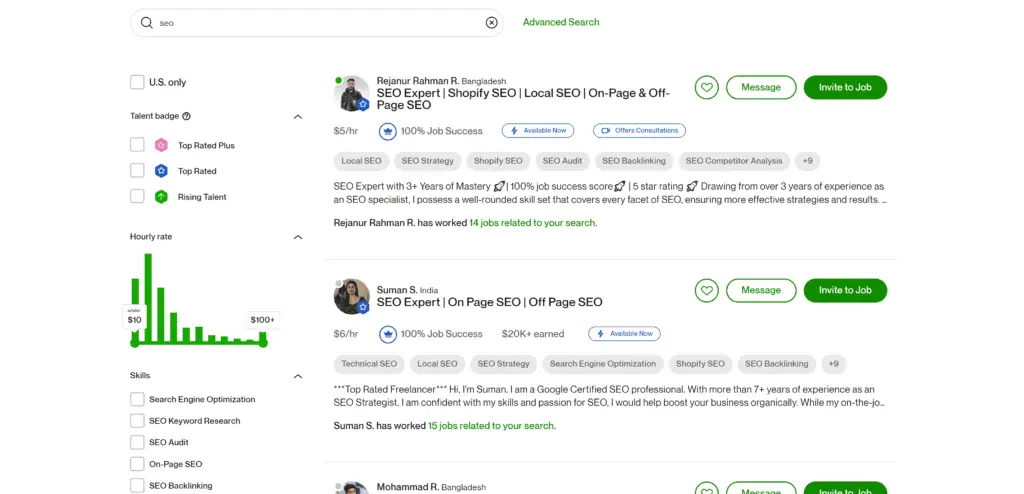
Identifying potential tasks to outsource is just the first step; the next crucial phase is vetting them to ensure they align with your business’s needs, values, and expectations.
This lesson will guide you through the process of finding and thoroughly vetting outsourcing partners.
Where to Find Potential Outsourcing Partners
Where you find outsourced partners is largely dependent on your industry. However, there are a few options that I like to use that have proven to be very helpful in finding outsourced providers.
1. Online Freelance Marketplaces
Upwork, Freelancer, and Fiverr are the most popular platforms in the gig economy. They host a wide range of freelancers with diverse skill sets, from data entry and customer support to more specialized services like graphic design and software development.

These platforms allow you to review freelancers’ profiles, portfolios, and client feedback to help you make informed hiring decisions. The reviews and portfolios, in my opinion, offer the best gauge of quality.
These are what I use while searching for a provider myself. I almost never have to search elsewhere because the filtering capabilities are so powerful.
Toptal and Guru cater to businesses looking to hire top-tier freelancers. Toptal, for instance, prides itself on providing the top 3% of freelance talent, specializing in software development, financial expertise, and product management.
If I were to need in-depth strategy work on consulting-type arrangements, I would look at these platforms. Think about fractional CFO, CMO, COO, etc…
2. Professional Networking Sites
I have found that LinkedIn can be a powerful tool for finding both freelancing professionals and outsourcing companies. Instead of searching though, you can use the platform to essentially ask for help.
You can use LinkedIn to post job offers, search for providers, or reach out through your network for recommendations. While using this method, you’ll likely receive a lot of referrals from connections you trust.
3. Social Media Groups and Forums
Groups on Facebook or LinkedIn, and forums like Reddit can be goldmines for referrals and advice on outsourcing providers. Such platforms allow for open discussions about experiences with specific freelancers or companies.
Similar to asking for help on LinkedIn, you can simply ask for a referral in a social group and you’ll likely get quite a few recommendations from people in your industry who have used a partner and found success doing so.

4. Industry Conferences and Trade Shows
Attending relevant industry events can connect you directly with outsourcing service providers.
These venues are ideal for networking, gaining industry insights, and meeting potential partners in person, which can be crucial for establishing trust and a successful working relationship.
This can be especially beneficial in industries that require a high level of specialization like manufacturing or ecommerce.
Where I DON’T Look
I really don’t waste my time with B2B directories or local business networks. Yes, you might be able to find a provider using either, but I don’t think these are the best provider options.
Almost every business directory or Chamber of Commerce has some type of service to fit your need, but they’re probably going to be promoted to be listed there. Sponsorships are expensive, and companies usually pass those costs along to the consumer.
I also don’t use consulting and referral agencies – firms that specialize in connecting businesses with outsourcing partners.
These agencies can provide personalized services to help you find the best fit for your specific needs, but I highly suggest staying away. They’re expensive and usually don’t do much more than what you would do by searching Google and reading reviews.
Evaluation Criteria
Once you identify the area that you’d like to outsource, the next thing to do is to establish a litmus test that you can use as a quick way to narrow down vendors.
First, I like to review the websites and social media profiles to understand the provider’s services, values, and client base. Then, I quickly scan reviews and testimonials to get an idea of client satisfaction and quality of work.
If those things check out, I do a deeper dive.
1. Expertise and Experience
When selecting an outsourcing provider, start by evaluating their technical expertise, including qualifications, certifications, and proficiency in critical technologies relevant to your project, such as necessary programming languages for software development.
Additionally, assess their industry-specific experience, including understanding regulatory challenges and competitive dynamics, which is crucial for tailored solutions.
Consider their business longevity and track record, as well-established firms are often more reliable and adept at managing complex projects.
2. Quality of Work
One of the easiest things to look for is the quality of a vendor’s work.
Can they meet or exceed your quality standards? What proof do they have that can back up their claims?
An easy way to validate this is to ask for case studies or references that can vouch for them. I usually try to ask for examples specific to my task so that I can get a good idea of what the quality of their deliverables are.
Once I contact a previous client, I inquire about their experience working with the provider, focusing on reliability, quality of work, and communication.
If they don’t have a history of quality work in the past, or they are hesitant to show you projects they’ve worked on previously, count this as a huge red flag and seek out another vendor.
3. Cost
When examining costs, look beyond just the initial service fees.
Oftentimes, there are additional expenses baked into the costs that a vendor might not be very up-front with. This industry is full of companies looking to nickel-and-dime you.
Consider additional expenses such as the costs associated with transitioning services to the provider, ongoing management fees, and any potential costs for scaling services up or down.
A great way to discover these fees is asking something along the lines of “Are these prices full-service or are there other fees that I’ll incur along the way?”.
Ideally, you will get this in writing as a fall-back in case you do get charged in the future.
There are, however, some great companies that offer simple pricing plans as part of their business model. Take for example the pricing page of DesignPickle, an outsourced provider of graphic design services:

As you can see, their pricing is simple and up-front. I actually chose this company to provide my portfolio’s graphic design services because of how easy it is to use and budget for.
When seeking a vendor, I try to go after this model to eliminate hidden costs entirely. If you look around enough, you’ll likely find one.
4. Communication and Expectations
Effective communication is key to a successful outsourcing partnership. Finding an outsourcing vendor who can communicate well is critical for success.
Try to assess the provider’s proficiency in your preferred language and their ability to communicate clearly and efficiently.
You’ll thank me later for this. I’ve gone with the cheapest provider before, but one that didn’t communicate well. Failing to take this simple step led to SO much frustration and inefficiency that could have easily been avoided.
Also, consider their availability in your time zone or their willingness to adapt their working hours to ensure timely and effective communication. This can greatly help with how smooth the day-to-day operations run.
The best part about the time zone arbitrage is that if you time things correctly with your provider, you can go to bed while they are working. In theory, your business is always running at peak performance.
5. Security
Lastly, ensure that your partner has an appropriate level of security – especially while handling sensitive or confidential data.
Some easy things to ask about are what best practices that are followed as a way of protecting data, or their compliance with data security standards and regulations.
Think about both on-site and off-site scenarios, too.
- Does your company transmit documents or confidential data? How will those be handled?
- Do contractors have their own devices, or are they given company-provided devices?
- What happens when a contract gets fired or leaves the outsourced provider? Is their access immediately revoked?
There are many different scenarios to think through, and they vary widely by company.
However, the main thing to think about is to ensure they have robust security protocols that are compatible with your own security requirements to prevent any potential data breaches or security issues.
6. Cultural and Operational Fit
It’s vital to assess the compatibility of an outsourcing provider’s business culture and operational processes with your own. This step is key to eliminating potential partners that might introduce tension, frustration, or inefficiency into the relationship.
I focus on determining whether their values, communication style, and business ethics align with my company’s ethos. Understanding their approach to teamwork, customer service, and conflict resolution is crucial as it offers insights into how seamlessly they will integrate with our team.
Furthermore, it’s important to evaluate their operational procedures to ensure they match our workflow and meet our performance expectations.
Proper alignment not only promotes smoother collaboration but also boosts the efficiency and productivity of the partnership, ultimately enhancing the results we achieve together.
4. Shortlisting Vendors
Now that you’ve pinpointed the operations you wish to outsource, it’s crucial to move forward with a strategic plan to ensure successful outsourcing partnerships.
Due Diligence
Before finalizing an outsourcing provider, conduct comprehensive research into your shortlisted candidates.
This includes examining their track records, reviewing references, and analyzing case studies that demonstrate their ability to deliver on similar projects. It’s vital to assess their financial stability, industry reputation, and the quality of their client service.
This thorough vetting helps mitigate risks and ensures you choose a provider that aligns with your quality standards and business needs.
Start Small
To effectively gauge a provider’s capability and compatibility with your company, consider initiating a pilot project. This approach allows you to test their services on a smaller scale without significant commitment.
Evaluate how well they meet deadlines, their responsiveness to feedback, and the quality of the final deliverables.
Starting small provides practical insights into the working relationship you might expect in a longer-term engagement.
Strategically Implement Growth
Throughout the outsourcing process, it is crucial to stay aligned with your business’s core values and long-term objectives.
When executed correctly, outsourcing is more than just a cost-cutting exercise; it is a strategy that can drive significant growth and operational efficiency.
This alignment ensures that the outsourcing decisions support your overall business strategy and contribute to its long-term success.
Maintain regular oversight and clear communication with your outsourcing partner to ensure that all activities are aligned with your business goals and that any issues are addressed promptly, ensuring a productive and mutually beneficial relationship.
Practical Steps
- Compile a Shortlist: Based on your initial research, compile a list of potential partners who meet your basic requirements.
- Develop a Request for Proposal (RFP): For more complex services, consider developing an RFP that outlines your project requirements and asks for detailed proposals from potential partners.
- Conduct Interviews: Arrange interviews with the shortlisted candidates to discuss your project in detail and assess their understanding and capability.
- Perform a Trial Project: If possible, start with a small project to evaluate the partner’s performance before committing to a larger contract.
Final Thoughts
Finding and vetting outsourced partners is a meticulous process that requires time and effort but is crucial for establishing a fruitful outsourcing relationship.
By carefully selecting partners that not only have the technical capability and experience but also align with your business culture and values, you can mitigate risks and maximize the benefits of outsourcing.
Next Steps:
- Begin the process of identifying potential outsourcing partners using the strategies discussed.
- Implement the vetting process to evaluate your shortlisted candidates thoroughly.
- Plan and execute a trial project with the most promising partner(s) to assess compatibility and performance.

